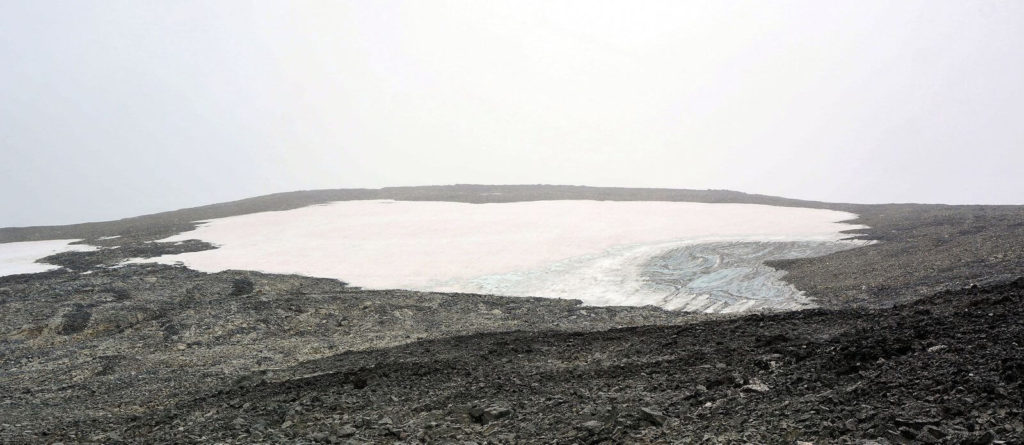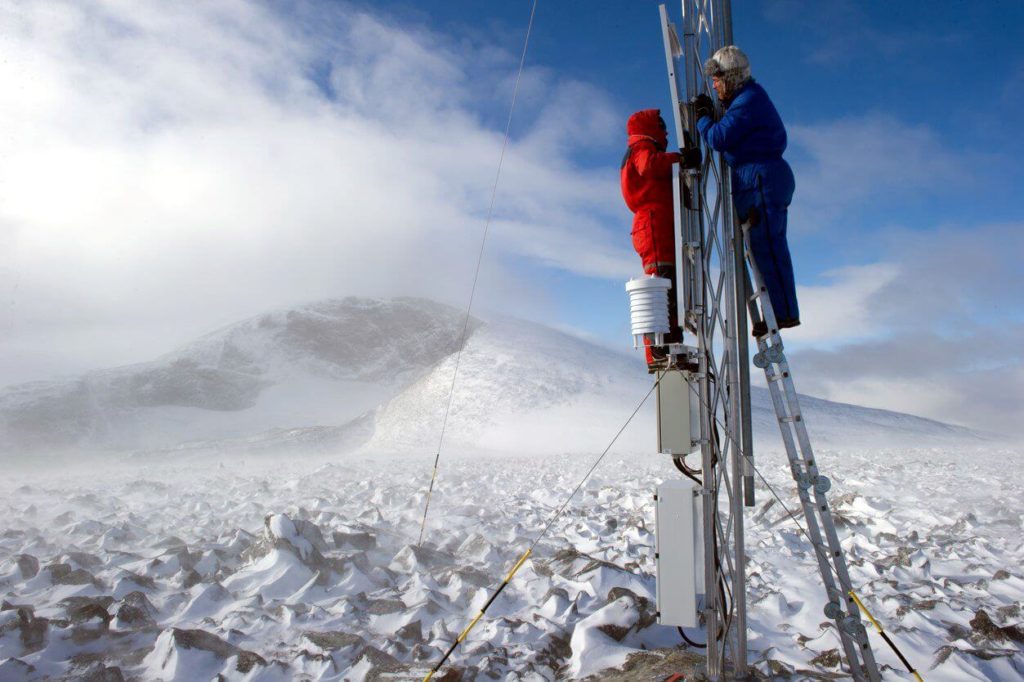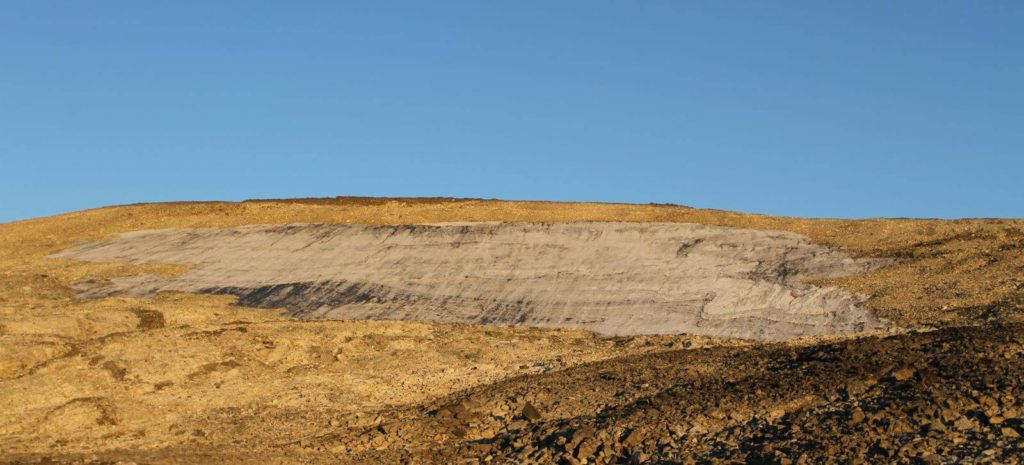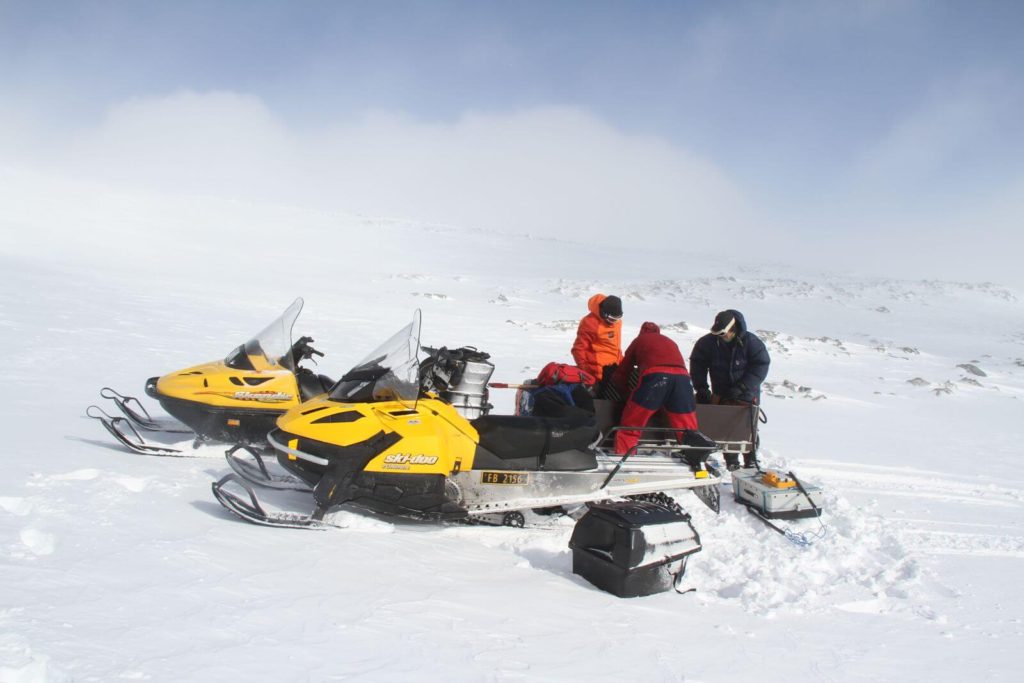It is February. I am at an ice patch together with my colleagues. It should be freezing cold, but instead the ice is melting. A thick layer of ancient reindeer dung is exposed on the surface of the ice patch, mixed with archaeological finds. What is going on? We should not have a melt for another three months at the earliest. Is all the ice melting at once? I am trying to grasp the enormity of the situation, when night comes suddenly, and we struggle to make it back to our camp in the darkness.
At this point, I woke up. It was just a dream, albeit an apocalyptic one. However, as the dream vanishes, a sense of premonition remains. The reality is that the ice in the high mountains is doomed due to global warming. Scientists tell us that the mountain ice will disappear, and most of it will be lost in this century. This is a reality that is hard to comprehend, intellectually and emotionally.
How will the ice melt?
I started thinking about the nature of the on-going ice melt early on in my work as a glacial archaeologist. In a 2014 article in Science, I wondered: “The ice is going (…) It’s like a story where you know the ending, but not the plot. Is it going to go quickly, or is it going to take its time?” Are we looking towards a gradual melt of the ice, or could we experience a dramatic meltdown and massive loss of invaluable artefacts?
This is a difficult question, but an important one – and not just to glacial archaeologists, but to society as a whole. Clues to the answer lie both in the nature of the ice patches and in the development of climate change. The demise of the ice patches and mountain glaciers will of course be of less importance globally than the melting of the Antarctic and Greenland ice caps. Still, saying farewell to mountain ice will have a profound effect on local communities and nature depending on this resource. Where will the water for drinking and irrigation come from in the summer? Where will the reindeer find a safe haven from pestering insects on hot days?

How will climate change affect the ice patches?
To understand how ice patches are affected by the on-going climate changes, we first have to understand how they come into existence. Ice patches develop in the wind-shade of prominent topographical features such as mountaintops and -ridges. Typically, they form on the northern side of such features, where the solar radiation is less pronounced. The shapes and sizes of ice patches depend on the local terrain, and thus vary a lot. (For information on the difference between glaciers and ice patches see here)
The ice patches feed on wind-drifted snow during the winter. Remarkably, a new study has shown that the general snowfall is of less importance than the wind-drifted snow (read the study here). Depending on the direction and the strength of the wind, the ice patches will collect a certain amount of snow during the winter. Without the wind-drifted snow, the ice patches would not exist.
The ice patches melt in the summer, depending on temperature, solar radiation, wind and rain. If more snow is collected by the ice patches during the winter than melts in the summer, the ice patches expand. In the opposite situation, they contract, sometimes quite rapidly so. Many of the ice patches have a type of self-sustaining feedback mechanism. If they melt a lot, the wind-shade area will increase. This increases the amount of wind-drifted snow they are potentially able to collect in the winter.
The on-going climate changes affect the ice patches in several ways, three of which are the most important in this context. Obviously, increasing temperatures result in the thaw starting earlier in the spring than previously and continuing later in fall. In 2016, we had about six more weeks of melting than normal. This type of prolonged melt has a clear negative impact on the ice patches.
Changes in precipitation also play a role. Increased precipitation will add more snow in the winter, but with the prolonged melting season, a greater portion of the downpour will be rain, not snow. It used to be believed that rain was a real snow-killer, but rain is normally quite cold at high altitude. It is rather the connected weather conditions, which cause the melting. Energy from the humid air is transferred to the snow, and leads to condensation of water vapor on the snow surface. The degree of condensation is depending on wind speed – more wind, more condensation.
There is a lesser understood, but important factor adding to the quotation here: winter melt spikes in the high mountains. While such temperature spikes may not actually lead to significant melting, they do have an important effect: The top snow layer melts and water permeates down into the snow below. The water refreezes below the snow surface and solidifies the snow deposits, decreasing or even stopping the snowdrift. As mentioned, ice patches feed on snowdrift, and with a decrease in drift, this would obviously make the ice patches catch less winter snow. This would make them more prone to contract during summer melting. As an aside, melt spikes in the winter also cause a lot of trouble for reindeer, as the resulting hard snow and ice makes it difficult for them to access lichen and moss below the snow.

We have had five melt spikes of +4oC or more during the 2016/17 winter here in Oppland. One of these melt spikes, on February 13th, set an all-time mid-winter measured temperature record in the Norwegian high mountains at +6.5 0C. The average temperature for this date is -11.1 0C. Based on the climate prognosis, such melt spikes will become more frequent and more severe in the years to come. A similar increase in melt spikes is also seen elsewhere in the Arctic (read here and here).
Could the ice patches melt in one year?
The ice patches are facing higher temperatures, prolonged melting, more rain and less wind-drift. They are clearly going to melt away, but will this be a drawn-out process or could they melt in one dramatic event? This depends on the size of the ice patches, their topographical situation and their thickness.

Let us take the upper ice patch at our secret arrow site in the Jotunheimen Mountains as an example. Radar measurements have shown that this ice patch has a maximum depth of 10 m. What would it take to melt this ice patch completely within one melt season? Is it at all possible? A 2010 incident at the Juvfonne ice patch has shed light on this. The 2009/2010 winter only led to the accumulation of 2 m of snow on Juvfonne, due to little snow and little snowdrift. The summer had a normal temperature. In August 2010, Juvfonne experienced strong, warm and wet winds from a southeasterly direction for ten days. This led to extreme melting of ice. By the end of the melting season, the ice patch had lost almost 5 meters of ice thickness, most of this probably during the dramatic melting event. The most affected area was facing southeast.
If we get a winter with little snow and little snowdrift, followed by a very warm and long summer interspersed with periods of warm and humid winds, then a dramatic meltdown will happen. None of these weather phenomena are off the charts, but we would need a combination of all of them, not just some of them. Moreover, since ice patches mostly face north they would not be as directly influenced by the warm southerly winds as in the case of Juvfonne. Our secret arrow site is southeast facing though, and would get a direct hit. It appears possible that it could melt completely in one year under the right (or rather wrong) circumstances. On the other hand, the ice here appears to date back to before 4000 BC, which does point to a remarkable resilience. Therefore, while it is possible that it could melt in one year, it is perhaps not likely.

To get solid information on the future melt of the ice patches we need to get more ice science done, especially investigating more sites with ice penetrating radar and extraction of ice cores. This way, we will gain knowledge on their size and depth, on when their ice started to form and how they have developed during the different climatic conditions since then. This basic information would be very helpful when trying to model the future development of the ice patches under possible climate scenarios.
What are chances that we will experience an apocalyptic winter melt in the future?
Getting back to the winter melt in the dream, such dramatic melts in the high mountains are not entirely unheard of. A warm, very wet Pacific storm in February 1996 caused a significant flooding event in Cascades in the USA. At one measuring station, 1.75 m of snow was lost in just six days.
However, the winter climate of our high mountains in Oppland is very different from the Cascades. The average temperature at Juvvasshøe (1894 m) in February is below -11oC, and while we see melt spikes, they are just that – spikes, not prolonged melting. If we get a winter with little or no snow, interspersed with melt spikes, we could theoretically experience a winter melt of the ice patches exposing old ice in the next decades. However, chances are slim that it would be anything more than episodic, not prolonged and dramatic. Dramatic winter melts, like the one in the dream, are not a realistic scenario in the near future. If we get a 4oC (7oF) or more increase of temperature or run-away warming due to natural feedback mechanisms, the situation could become very different. However, in that case archaeology would probably not be much of a priority.
